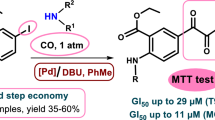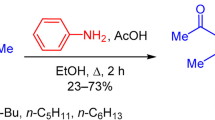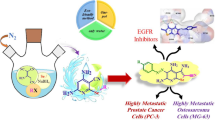Abstract
The β-ribofuranosylazide1 is transformed after usual derivatization by suitable protecting groups into the P–N-ylid2, which gives the corresponding N-Glykosyl-N-alkylcarbodiimides4 and a small amount of the glykosylisocyanatde-rivative3 by reaction with alkylisocyanates. The carbodiimides4 were reacted with hydrazoic acid to give the alkylaminotetrazolnucleosides5 and finally the free nucleosidanalogs6. In the case of5 c the 5-aziridinyltetrazolnucleosid5 h was formed by an usual neighbouring group reaction. In addition the compound1 is transformed into the 3′,5′-diprotected anchor derivative7 by reaction withTIPSCl2. The latter could be transformed by usual steps into the alkylaminotetra-zolnucleosides8 with a free 2′-OH group. In the next step the 2′-p-tolylthiocarbo-nates9 were prepared followed by transformation to the 2′-desoxynucleosides10 by means of tributyltinhydride. Finally the free 2′-desoxynucleosides11 were prepared. By reacting the carbodiimides4 with phenylisocyanate a mixture of the two possible regiouretidinonnucleosidderivatives12 and13 are formed. In the case of the N-glykosyl-N-allylcarbodiimide4 d only the one isomer13 d arises.
Similar content being viewed by others
Literatur
2. Mitt.Zbiral E., Schörkhuber W (1982) Liebigs Ann Chem 1982: 1870
Suhadolnik RJ (1970) Nucleoside antibiotics. Wiley Interscience, New York; Nucleosides as biological probes ibid (1979)
Shen TY (1970) Angew Chem 82: 730; Int Ed Engl 9: 678
Luepke U., Seela (1978) Chem unserer Zeit 12: 189
Badrach U., Schnur LF, El-On J, Greenblatt CL, Pearlman E, Robert-Géro M, Lederer E (1980) FEBS Lett 121: 287
Jiono K, Suzuki S (1968) Tetr Lech 1968: 1133
Schmidt RR, Karg J, Guilliard W (1977) Chem Ber 110: 2433;
Schmidt RR, Heermann D (1981) ibid 114: 2825;
Schmidt RR,Guilliard W,Heermann D (1981) Liebigs Ann Chem;
Schmidt RR, Guilliard W, Heermann D, Hoffmann M (1983) J Heterocycl Chem 20: 1447
Dudycz L, Shugar D, De Clercq E, Descamps J (1977) J Med Chem 20: 1354;
Norang AS, Vince R (1977) ibid 20: 1684
De Clercq E, Eckstein F (1979) Nucleoside, analogues, chemistry, biology and medical applications. In:Walker RT (ed) Nato Advanced Study Institutes Series. Plenum, New York London
Sidwell RE, Huffman JH (1972) Science 177: 705
Shrivastava PC, Revankar GR, Robins RK (1984) J Med Chem 27: 266
Nelson V, El Khadem HS, Whitten BK, Sesselman D (1983) J Med Chem 26: 1071
Seldes AM, Thiel JME, Deferrari JO (1975) Carbohydr Res 39: 47
Baker JJ, Nivan AM, Tittensor JR (1974) Tetrahedron 30: 2939
Poonian MS, Nowoswiat EF, Blount JF, Kramer JM (1976) J Med Chem 19: 1017
Schörkhuber W., Zbiral E (1980) Ann Chem 1980: 1455
Benmann MJ, Lehman JR, Adler J, Zimmermann SB, Simmes ES, Koenberg A (1958) Proc Natl Acad Sci USA 44: 633
Beyermann HC, Bontekoe JS (1962) Rec Trav Chim 81: 690
Wolf H (1946) Org React 3: 307
Robins MJ, MacCoss M (1977) J Amer Chem Soc 99: 4654;
Jung RH, Schmidt RR (1980) Chem Ber 113: 1775
Markiewicz WT, J Chem Res Miniprint 181 (1979);
Robins MJ, Wilson JS (1981) J Amer Chem Soc 103: 932
Ponkiewicz K, Matouda A, Watanabe KA (1982) Org Chem 47: 485
Robins MJ, Wilson JS, Hansske F (1983) J Amer Chem Soc 105: 4059
Ulrich H (1967) Cycloaddition reaction of heterocumulenes. Academic Press, New York
Ulrich H, Tucker B, Sayigh AAR (1972) J Amer Chem Soc 94: 3484
Still WC, Kahu M, Mitra A (1978) J Org Chem 43: 2923
Nelles J (1932) Chem Ber 65: 1345
Wolff H (1946) Org React 3: 307
Henry RA, Finnegan H, Lieber E (1954) J Amer Chem Soc 76: 2894
Author information
Authors and Affiliations
Additional information
Herrn Prof. Dr.A. Neckel mit den besten Wünschen zum 60. Geburtstag gewidmet.
Rights and permissions
About this article
Cite this article
Knotz, H., Zbiral, E. Glykosylazide als Ausgangsbasis zur Gewinnung von Nucleosidanalogen, 3. Mitt. Synthese von Alkylaminotetrazol- und Uretidinonnucleosiden. Monatsh Chem 117, 1437–1460 (1986). https://doi.org/10.1007/BF00810753
Received:
Accepted:
Issue Date:
DOI: https://doi.org/10.1007/BF00810753




